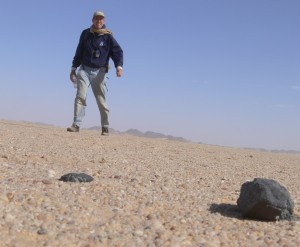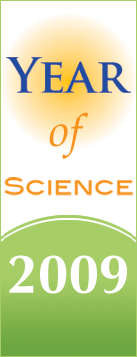
Peter Jenniskens with Meteorite fragments. Credit: SETI Institute
To get an idea of how exciting science can be, one need only look at the front page of today’s SF Chronicle. There in bold headlines: “Asteroid sheds light on dawning of solar system.” Okay, that doesn’t sound very exciting.
On Wednesday, NASA Ames and the SETI Institute revealed to journalists the interesting news that an asteroid, designated 2008 TC3, had been discovered on a collision course with the Earth; that its trajectory was calculated in order to predict the impact zone; its re-entry as a meteor had been witnessed; and that a team of astronomers and Sudanese students had recovered fragments of the meteorite in the Nubian Desert.
The meteorite fragments will be a valuable addition to our knowledge of the early solar system, according to SETI scientist Peter Jenniskens:
…the one that yielded Jenniskens’ fragments after exploding with the energy of 1,000 tons of TNT was a very rare F-class object called a ureilite. It was extremely fragile, fine-grained, porous and probably weighed nearly 90 tons before its sharp-edged fragments fell to Earth, Jenniskens said.
Intriguing speculation about the asteroid’s origins came from Lucy McFadden:
Lucy McFadden, an astronomy professor at the University of Maryland who specializes in asteroid research, was not part of the team, but she joined Wednesday’s teleconference to note that the fragments are particularly significant because they show evidence of volcanic activity and melting in the distant past.
It was probably part of a much larger body – “I’d call it a planet,” she said – that formed and then crashed against other objects as the crowded early solar system was forming all those billions of years ago.
However, for a farm more exciting peek into how astronomers located around the globe now routinely collaborate using the latest technology, often acting within minutes of receiving emails on their Blackberrys, check out this article on 2008 TC3 in Nature. Sounding like the treatment for the opening scenes of Deep Impact, author Roberta Kwok retells astronomer Richard Kowalski’s discovery of what was 2008 TC3:
The only thing that had puzzled Kowalski about the midnight blip was the Minor Planet Center’s response to his report. Its website posted the discovery right away but when he tried to add more data, the system stayed silent.
Pretty ominous. Tim Spahr, director of the MPC is flagged when the Center’s computers can’t calculate the orbit of an object so close to the earth, so he runs another set of calculations and realizes he has to make a call to Lindsey Johnson of NASA’s NEO:
The brightness of 2008 TC3 suggested it was only a few metres across and, assuming it was a common rocky asteroid, would probably split into fragments soon after entering the atmosphere. But safe as that might seem, Spahr had procedures to follow. He called Lindley Johnson, head of NASA’s Near Earth Object Observations programme in Washington DC, on his BlackBerry — a number only to be used in emergencies.
“Hey Lindley, it’s Tim,” said Spahr. “Why would I be calling you?”
Johnson’s response: “We’re going to get hit?”
The article goes on to describe the astronomical relay race as one after the other, astronomers fire off emails, make rapid calculations, and collect addtional data as they follow the destiny of asteroid 2008 TC3. Eventually, a Dutch meteorologist named Jacob Kuiper will enlist the aid of KLM Airlines to help with tracking the entry point:
With less than 45 minutes left, Kuiper realized he could notify Air France-KLM — the airline to which he routinely issued weather reports — which probably had planes flying over Africa. About ten minutes later, pilot Ron de Poorter received a message print-out in the cockpit of KLM flight 592, flying north from Johannesburg to Amsterdam. The message gave the latitude and longitude of the predicted asteroid impact. De Poorter calculated that he would be a distant 1,400 kilometres from the collision. Still, at the appointed time he and his co-pilot dimmed the instrument lights and peered northeast.
[…]
From the cockpit of his plane, de Poorter saw flickerings of yellowish-red light beyond the horizon, like distant gunfire. The flash woke a station manager at a railway outpost in Sudan. In a village near the Egyptian border, people returning from morning prayers saw a fireball that brightened and flared out, according to accounts collected later by researchers.
SETI astronomer Jenniskens goes to the impact site with students from the University of Khartoum in an attempt to recover the debris.:
On 6 December 2008, Jenniskens and Shaddad set out with a group of 45 students and staff from the University of Khartoum to scour the area. Team members lined up about 20 metres apart over a kilometre-wide strip, facing a sea of sand and gravel interspersed with hills, rocky outcrops and dry winding riverbeds. Flanked by two pairs of cars and trailed by a camera crew from news network Al Jazeera, the line of searchers began marching slowly east, like the teeth of a massive comb being dragged through the desert.
Towards the end of the day, a car approached Jenniskens with news that a student might have found a meteorite. “I remember thinking, ‘oh no, not again’,” says Jenniskens, who had already fielded several false alarms. Still, he jumped in the car and drove to the student, who presented him with a small square fragment, about a centimetre and a half across with a thin, glassy outer layer. The surface resembled the crust that meteorites form after being melted and solidified, and the rock’s deep black colour suggested it was freshly fallen. It was the team’s first meteorite — and the first time that scientists had ever recovered a meteorite from an asteroid detected in space.
The article is well worth the read, but the published paper itself is behind a firewall.
For another take on the discovery by SETI Institute Senior Astronomer Seth Shostak, check out SETI Institute’s website.
Update 1: Amir Alexander of the Planetary Society has an article about 2008 TC3.
Update 2: The commenters at BadAstronomy.com note Planetary Society blogger Emily Lakdawalla’s account from October of last year.
Update 3: A link to the original email to the Minor Planets Mailing List. You can do a search in the group for “TC3” to find even more messages.







{ 0 comments… add one now }
You must log in to post a comment.